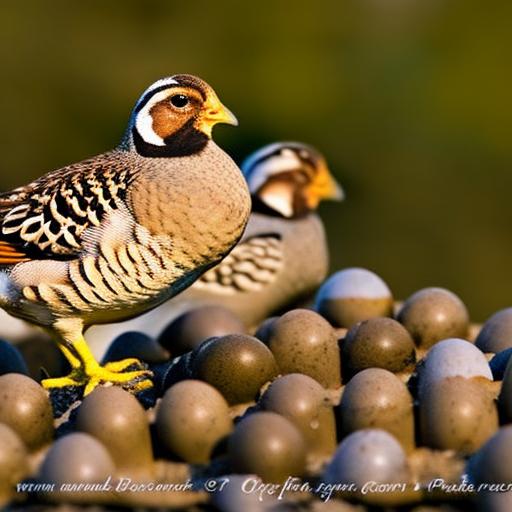Quails are small, ground-dwelling birds that belong to the pheasant family. They are known for their delicious eggs and tender meat, making them a popular choice for poultry farming. There are many different quail breeds, each with its own unique characteristics and qualities. Some breeds are specifically bred for egg production, while others are raised for their meat. Additionally, there are ornamental quail breeds that are prized for their beautiful plumage and rare quail breeds that are in danger of extinction. Whether you are a commercial farmer, a hobbyist, or an exhibitionist, there is a quail breed that will suit your needs. In this article, we will explore the different types of quail breeds and their specific uses, as well as provide guidance on selecting the right breed for your needs.
Key Takeaways
- There are various quail breeds suitable for different purposes such as egg production, meat production, ornamental purposes, hobbyists, and exhibition.
- Popular quail breeds for egg production include Coturnix quail, Bobwhite quail, and California quail.
- Quail breeds for meat production include Jumbo Coturnix quail, Bobwhite quail, and Italian quail.
- Ornamental quail breeds such as Chinese Painted quail and Blue Scale quail are known for their attractive plumage and are often kept for decorative purposes.
- Rare and endangered quail breeds like the Himalayan quail and the Harlequin quail require special attention and conservation efforts to prevent extinction.
Popular Quail Breeds for Egg Production
When it comes to egg production, some quail breeds stand out for their high egg-laying capabilities. The Coturnix quail, also known as the Japanese quail, is one of the most popular breeds for egg production. They are known for their prolific egg-laying abilities, with some hens laying up to 300 eggs per year. Coturnix quails come in a variety of colors, including brown, white, and tuxedo, making them a visually appealing choice for farmers and hobbyists alike. Another popular breed for egg production is the Bobwhite quail. While they may not lay as many eggs as Coturnix quails, Bobwhite quails are valued for their large, nutritious eggs and excellent maternal instincts. They are also known for their adaptability to different climates and are often raised in large commercial operations.
For those looking for a more unique option, the Blue Scale quail is a popular choice for its striking appearance and good egg-laying capabilities. These quails have a distinctive blue-gray plumage with white spots, making them a visually stunning addition to any flock. In addition to their beauty, Blue Scale quails are known for their ability to lay a good number of eggs, making them a desirable choice for both commercial and backyard egg production. Overall, when it comes to egg production, there are several popular quail breeds to choose from, each with its own unique qualities and benefits.
Quail Breeds for Meat Production
Quails are not only valued for their eggs but also for their tender and flavorful meat. When it comes to meat production, the Coturnix quail is once again a popular choice. In addition to being prolific egg layers, Coturnix quails are known for their fast growth rate, reaching market weight in just 6-8 weeks. This makes them an efficient choice for meat production, especially for those looking to raise quails on a commercial scale. The Jumbo Coturnix quail is a specific strain of Coturnix quail that has been selectively bred for larger size and meat production. These birds can reach up to 12 ounces in weight, making them an ideal choice for those looking to raise quails specifically for meat.
Another popular breed for meat production is the Bobwhite quail. While they may not grow as quickly as Coturnix quails, Bobwhite quails are valued for their tender and flavorful meat. They are often raised in small-scale operations or backyard farms, where their meat is highly prized for its delicate flavor and texture. Additionally, the Texas A&M quail is a specific strain of Bobwhite quail that has been bred for rapid growth and high meat yield. These birds are known for their plump bodies and delicious meat, making them a popular choice for those looking to raise quails for meat production. Overall, there are several quail breeds that are well-suited for meat production, each with its own unique qualities and advantages.
Ornamental Quail Breeds
In addition to their practical uses for egg and meat production, some quail breeds are prized for their ornamental qualities. The King quail, also known as the button quail, is one of the most popular ornamental quail breeds. These tiny birds are known for their vibrant plumage and small size, making them a charming addition to aviaries and ornamental bird collections. King quails come in a variety of color mutations, including silver, cinnamon, and pearl, making them a visually stunning choice for those looking to add some color and diversity to their bird collection.
Another ornamental quail breed is the Gambel’s quail, which is native to the southwestern United States. These birds are known for their striking plumage, with males sporting a black face mask and chestnut-colored belly, while females have a more subdued brown and cream coloration. Gambel’s quails are often kept in aviaries or as part of ornamental bird collections due to their beautiful appearance and charming behavior. Additionally, the California quail is another popular ornamental breed known for its distinctive plume on its head and elegant markings. These birds are often kept in captivity for their beauty and are a popular choice for those looking to add some visual interest to their bird collection. Overall, ornamental quail breeds offer a unique and visually appealing option for bird enthusiasts and collectors.
Rare and Endangered Quail Breeds
While some quail breeds are popular and widely available, there are also rare and endangered quail breeds that are in danger of extinction. The Himalayan quail is one such example, with only a few confirmed sightings in the last century. This elusive bird is native to the Himalayan region of India and is considered critically endangered due to habitat loss and hunting pressure. Efforts are being made to conserve the remaining population of Himalayan quails through habitat protection and captive breeding programs in an attempt to prevent their extinction.
Another rare quail breed is the Stubble quail, which is native to Australia. This small ground-dwelling bird has experienced population declines due to habitat loss and degradation caused by agriculture and urban development. Conservation efforts are underway to protect the remaining populations of Stubble quails and restore their natural habitat in order to ensure their long-term survival. Additionally, the Blue Quail of Mexico is another rare and endangered species that is facing threats from habitat loss and degradation. Conservation organizations are working to protect the remaining populations of Blue Quails and raise awareness about the importance of preserving their natural habitat.
Overall, rare and endangered quail breeds face significant threats to their survival, but conservation efforts are underway to protect these unique birds from extinction.
Quail Breeds for Hobbyists and Exhibition

For hobbyists and exhibitionists, there are several quail breeds that are prized for their unique characteristics and visual appeal. The Chinese Painted quail, also known as the button quail, is a popular choice for hobbyists due to its small size and colorful plumage. These tiny birds come in a variety of color mutations, including silver, cinnamon, and pearl, making them a visually stunning addition to any aviary or bird collection. Chinese Painted quails are also known for their charming behavior and social nature, making them an entertaining choice for those looking to add some diversity to their bird collection.
Another popular choice for hobbyists and exhibitionists is the Japanese or Coturnix quail. These birds come in a variety of colors, including brown, white, tuxedo, and silver, making them a visually appealing choice for those looking to showcase different color variations at poultry shows or exhibitions. In addition to their attractive appearance, Coturnix quails are known for their calm temperament and ease of handling, making them an ideal choice for those looking to raise quails as pets or show birds.
Overall, there are several quail breeds that are well-suited for hobbyists and exhibitionists due to their unique characteristics and visual appeal.
Selecting the Right Quail Breed for Your Needs
When it comes to selecting the right quail breed for your needs, there are several factors to consider. If you are primarily interested in egg production, then Coturnix quails are an excellent choice due to their prolific egg-laying abilities and variety of color mutations available. For those looking to raise quails specifically for meat production, both Coturnix and Bobwhite quails are popular choices due to their fast growth rate and tender meat.
If you are interested in adding some visual interest to your bird collection or aviary, then ornamental quail breeds such as King quails or Gambel’s quails may be the right choice for you due to their vibrant plumage and small size.
For hobbyists and exhibitionists looking to showcase different color variations or unique characteristics at poultry shows or exhibitions, Japanese or Coturnix quails may be the ideal choice due to their variety of color mutations available and calm temperament.
Overall, when selecting the right quail breed for your needs, it’s important to consider your specific goals and preferences in order to choose the breed that best suits your requirements.
In conclusion, there are many different types of quail breeds available, each with its own unique characteristics and qualities. Whether you are interested in egg production, meat production, ornamental birds, rare species conservation, hobbyist pursuits or exhibition showcasing there is a breed that will suit your needs. By considering the specific traits of each breed and your own goals and preferences you can select the right breed that will best meet your requirements whether you’re a commercial farmer or a hobbyist looking to add some diversity to your bird collection or aviary.
If you’re interested in learning more about different bird breeds and their breeding habits, you might also want to check out this insightful article on the incubation period for goose eggs at Poultry Wizard. Understanding the incubation process is crucial for successful breeding, whether it’s quails, geese, or chickens.
FAQs
What are the different breeds of quails?
There are several different breeds of quails, including the Coturnix quail, Bobwhite quail, Gambel’s quail, California quail, and Mountain quail.
What are the characteristics of Coturnix quails?
Coturnix quails are known for their small size, fast growth, and high egg production. They come in a variety of colors, including brown, white, and speckled.
What are the characteristics of Bobwhite quails?
Bobwhite quails are native to North America and are known for their distinctive call. They are popular game birds and are often raised for hunting purposes.
What are the characteristics of Gambel’s quails?
Gambel’s quails are found in the southwestern United States and are known for their striking plumage and distinctive topknot. They are often found in arid desert regions.
What are the characteristics of California quails?
California quails are known for their distinctive teardrop-shaped plume on their heads. They are found in the western United States and are popular for their attractive appearance.
What are the characteristics of Mountain quails?
Mountain quails are found in the western United States and are known for their striking appearance, with a unique chestnut and gray plumage. They are often found in mountainous regions.
Meet Walter, the feathered-friend fanatic of Florida! Nestled in the sunshine state, Walter struts through life with his feathered companions, clucking his way to happiness. With a coop that’s fancier than a five-star hotel, he’s the Don Juan of the chicken world. When he’s not teaching his hens to do the cha-cha, you’ll find him in a heated debate with his prized rooster, Sir Clucks-a-Lot. Walter’s poultry passion is no yolk; he’s the sunny-side-up guy you never knew you needed in your flock of friends!







